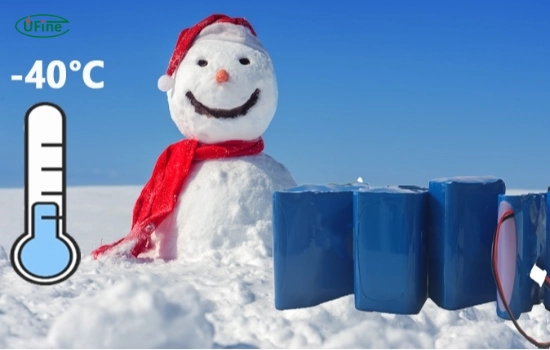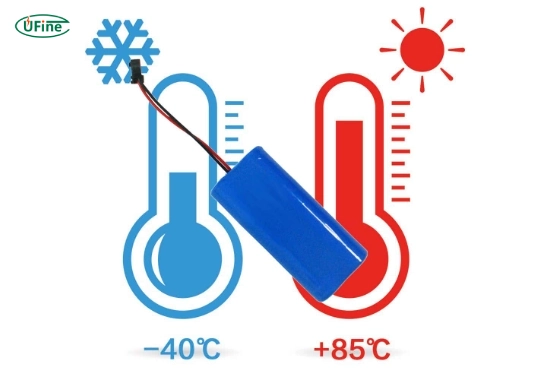The low temperature li-ion battery is a cutting-edge solution for energy storage challenges in extreme environments. This article will explore its definition, operating principles, advantages, limitations, and applications, address common questions, and compare it with standard batteries.
Part 1. What is the low-temperature lithium battery?
Low-temperature lithium batteries are specialized energy storage devices that operate efficiently in cold environments. Unlike traditional lithium-ion batteries, which experience performance degradation in low temperatures, these batteries are engineered with unique materials and structures to maintain functionality and reliability even in sub-zero conditions. They exhibit improved cold-weather performance, enhanced energy density, and prolonged lifespan, making them essential for various applications in cold climates.
Part 2. Low-temperature battery operating principle
Electrolyte Composition
- Low-temperature lithium batteries use special electrolytes to work well in cold places.
- These electrolytes differ from regular ones because they stay liquid and can conduct electricity even when cold.
- To make them better, they add ethylene carbonate (EC) and diethyl carbonate (DEC) to lower how cold they can get without freezing.
- They also use materials like lithium bis(trifluoromethanesulfonyl)imide (LiTFSI) to conduct better and stay stable in colder temperatures.
- The battery can charge and give power even when icy with a suitable electrolyte.
Cell Design and Construction
- How low-temperature lithium battery cells are made helps them work better in cold weather.
- They use unique materials for the parts inside to keep working even when it’s cold.
- Manufacturers often use graphite-based stuff for the parts that take in power and lithium iron phosphate for the parts that give it out because they work well in the cold.
- The way the cells are put together also helps. They might use unique shapes or coatings to make them strong and flexible, even when cold outside.
- They also use materials that won’t get in the way of the power moving around inside the battery.
- Sometimes, they even put heaters or sensors inside to keep the cells at the right temperature so they don’t stop working when it’s icy.
- Low-temperature lithium batteries work well even in icy places because they’re made to handle cold weather.
Part 3. Low-temp lithium battery advantages
Enhanced Performance in Cold Environments
- Low-temp lithium batteries excel in cold conditions, providing reliable power even in extreme cold.
- They maintain high energy density and efficiency, ensuring consistent performance in sub-zero temperatures.
Extended Lifespan
- Low-temp lithium batteries last longer in cold environments compared to standard batteries.
- Optimized electrolytes and electrodes reduce degradation, resulting in longer cycle life and less maintenance.
Faster Charging Capability
- These batteries charge faster than traditional options, which is ideal for applications requiring quick energy replenishment in the cold.
- Improved ion mobility and lower internal resistance enable rapid charging.
Versatile Applications
- Low-temp lithium batteries are versatile and suitable for various industries and environments.
- They effectively power vehicles, electronics, and renewable energy systems in cold climates.
Environmental Friendliness
- Low-temp lithium batteries support sustainability by reducing reliance on fossil fuels in cold regions.
- They enable using renewable energy sources in cold climates, contributing to environmental protection.
Cost-effectiveness
- Despite their specialized design, low-temp lithium batteries offer cost-effective solutions for cold-weather energy storage.
- The long-term benefits of extended lifespan, improved performance, and reduced maintenance costs outweigh the initial investment.
Part 4. Low-temperature lithium battery limitations
Reduced Capacity at Extremely Low Temperatures
- Low-temp lithium batteries may have less capacity in extreme cold and perform poorly.
- The electrolyte gets thicker and slows down the movement of ions, making the battery less efficient.
Increased Internal Resistance
- Cold weather can increase the battery’s internal resistance, making it harder to charge and discharge.
- This higher resistance can cause voltage drops and lower the battery’s power output.
Potential for Cell Damage
- Cold temperatures can stress the battery’s parts, leading to damage.
- Quick temperature changes can also cause problems like expansion and contraction, possibly harming the battery.
Impact on Longevity
- Low-temp lithium batteries in icy conditions might make them wear out faster.
- Things like freezing and thawing, the electrolyte getting solid, and the materials in the battery breaking down can all make it age faster.
Limited Operating Range
- Even though manufacturers design low-temp lithium batteries for cold places, these batteries still have limits.
- If it gets too cold, the battery might not work or be damaged, so you might need extra ways to control the temperature.
Part 5. Low-temperature lithium battery applications
Electric Vehicles (EVs) in Cold Climates
- Low-temperature lithium batteries are crucial for EVs operating in cold regions, ensuring reliable performance and range even in freezing temperatures.
- These batteries power electric vehicles’ propulsion systems, heating, and auxiliary functions, facilitating sustainable transportation in chilly environments.
Outdoor Electronics and Equipment
- Outdoor electronics such as GPS devices, cameras, and communication equipment rely on low-temperature lithium batteries to function in harsh weather conditions.
- Cameras used for photography in cold environments and iPads utilized for data collection or communication benefit from the durability and reliability of these batteries.
Aerospace and Aviation
- Low-temperature lithium batteries, including satellites, spacecraft, and uncrewed aerial vehicles (UAVs), are integral to aerospace applications.
- They provide power for critical systems, instrumentation, and communication devices in space missions and high-altitude flights, where temperatures can plummet.
Renewable Energy Storage Systems
- Low-temperature lithium batteries are vital in storing energy from renewable sources such as solar and wind power in cold climates.
- These batteries enable off-grid and hybrid renewable energy systems to operate efficiently, providing a stable power supply even in remote or cold environments.
Medical Devices and Healthcare
- Medical devices used in cold environments, such as portable defibrillators and diagnostic equipment in ambulances and emergency response units, rely on low-temperature lithium batteries for power.
- These batteries ensure the continuous operation of life-saving medical equipment, even in extreme weather conditions.
Military Applications
- Military operations often occur in cold and harsh environments, where reliable power sources are critical for communication, surveillance, and weapon systems.
- Low-temperature lithium batteries are used in military equipment, including radios, night vision devices, and uncrewed ground vehicles (UGVs), to maintain operational readiness in cold climates.
Part 6. Low-temperature batteries vs. standard batteries
Performance in Cold Conditions
- Low-temperature batteries are designed to maintain performance in cold environments. In contrast, standard batteries often experience reduced capacity and efficiency in low temperatures.
- Low-temperature batteries use specialized materials and electrolyte compositions to mitigate the effects of cold, ensuring reliable operation even in freezing conditions.
Capacity and Energy Density
- Low-temperature batteries may sacrifice some capacity or energy density to maintain performance in cold environments. In contrast, standard batteries typically offer higher capacity and energy density under normal operating conditions.
- Standard batteries may perform better in moderate temperatures but struggle in colder climates. In contrast, low-temperature batteries prioritize reliability over maximum capacity in cold conditions.
Cost and Affordability
- Low-temperature batteries may be more expensive to manufacture and purchase compared to standard batteries due to the specialized materials and design considerations required for cold weather performance.
- However, their ability to provide consistent power in cold climates may justify the cost of low-temperature batteries, reducing the need for frequent replacements or maintenance associated with standard batteries in such environments.
Application-specific Considerations
- The choice between low-temperature and standard batteries depends on the specific application and environmental conditions.
- Users prefer low-temperature batteries in applications where reliability in cold temperatures is critical, such as electric vehicles in cold climates or outdoor equipment used in winter sports.
- Applications prioritizing higher capacity or energy density over cold weather performance may find standard batteries more suitable.
Part 7. FAQs
-
What is the lowest battery temperature?
The lowest temperature at which most batteries can operate without damage is typically around -20 °C to -40 °C (- 4°F to 40°F). However, this can vary depending on the type of battery and its chemistry. -
What is the low temperature for a LiPo battery?
LiPo batteries perform best at temperatures above 0°C (32°F). Their operational range usually spans from around -20 °C (- 4°F) to 60°C (140°F). Still, they may suffer reduced performance and potential damage below freezing temperatures. -
What batteries are suitable for low temperatures?
Some batteries, like lithium iron phosphate (LiFePO4), are more resilient to cold temperatures and perform better in low-temperature environments. -
Does cold damage lithium batteries?
Yes, extreme cold can damage lithium batteries by reducing their capacity and causing them to lose power faster. -
How cold is too cold for LiFePO4 batteries?
LiFePO4 batteries can generally operate safely down to around -20°C. Beyond this temperature, their performance may decline, potentially damaging them.
Related Tags:
More Articles

LiPo Battery Discharge Rate Guide & Calculation Tips
Understand LiPo battery discharge rates, C-ratings, and how to calculate max current. Essential guide for RC, drones, and electronics users.
High‑Capacity 3S LiPo Batteries: 5000 mAh vs. 10000 mAh
Compare 3S LiPo 5000mAh vs 10000mAh batteries by weight, power, and use. Find the best fit for your drone, RC car, or boat setup.
Top 5 Applications for Small 3S LiPo Batteries
Small 3S LiPo batteries power drones, RC gear, wearables, and robotics with high energy and low weight. Making them ideal for compact electronics projects.
Building and Charging Your Own 3S LiPo Pack: A Step‑by‑Step Guide
Learn how to build, balance, and charge a 3S LiPo battery pack safely at home with this complete DIY guide for hobbyists and beginners.
How to Choose the Right LiPo Battery Plug Type?
Discover the best LiPo battery plug types, how to choose them, and expert tips for safe usage, soldering, and maintenance.





